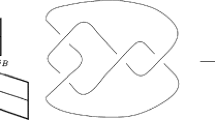Abstract
This paper is a report on the results of computer experiments with an algorithm that takes classical knots to what we call their “normal form” (and so can be used to identify the knot). The algorithm is implemented in a computer animation that shows the isotopy joining the given knot diagram to its normal form. We describe the algorithm, which is a kind of gradient descent along a functional that we define, present a table of normal forms of prime knots with 7 crossings or less, compare it to the knot table of normal forms of wire knots (obtained in [1] by mechanical experiments with real wire models) and (regretfully) present simple examples showing that normal forms obtained by our algorithm are not unique for a given knot type (sometimes isotopic knots can have different normal forms).
Similar content being viewed by others
References
A. B. Sossinsky, “Mechanical Normal Forms of Knots and Flat Knots,” Russ. J. Math. Phys. 18(2), (2011).
S. Matveev, Algorithmic Topology and Classification of 3-Manifolds (Springer Verlag, Berlin, 2004).
J. Cantarella, R. B. Kusner, and J. M. Sullivan, “On the Minimum Ropelength of Knots and Links,” Invent. Math. 150(2), 257–286 (2002).
Yuanan Diao, C. Ernst, and Xingxing Yu, “Hamiltonian Knot Projections and Lengths of Thick Knots,” Topology Appl. 136(1–3), 7–36 (2004).
S. Avvakumov, O. Karpenkov, and A. Sossinsky, “Euler Elastics in the Plane and the Whitney-Graustein Theorem,” Russ. J. Math. Phys. 20(3), 257–267 (2013).
O. Karpenkov and A. Sossinsky, “Energies of Knot Diagrams,” Russ. J. of Math. Phys. 18(3), 306–317 (2011).
J. O’Hara, Energy of Knots and Conformal Geometry (K & E Series on Knots and Everything, Vol. 33, World Scientific, 2003, p. 288).
M. H. Freedman, Z.-X. He, and Z. Wang, “Möbius Energy of Knots and Unknots,” Ann. of Math. 139(2), (1), 1–50 (1994).
S. Bryson, M. H. Freedman, Z.-X. He, and Z. Wang, “Möbius Invariance of Knot Energy,” Bull. Amer. Math. Soc. (N.S.) 28(1), 99–103 (1993).
Author information
Authors and Affiliations
Corresponding author
Rights and permissions
About this article
Cite this article
Avvakumov, S., Sossinsky, A. On the normal form of knots. Russ. J. Math. Phys. 21, 421–429 (2014). https://doi.org/10.1134/S1061920814040013
Received:
Published:
Issue Date:
DOI: https://doi.org/10.1134/S1061920814040013



